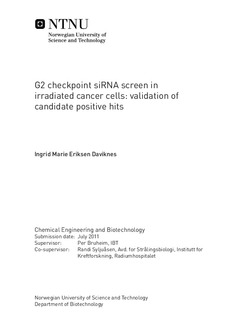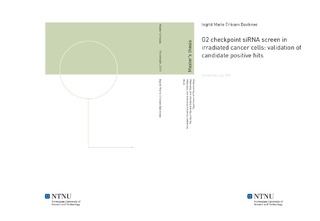| dc.contributor.advisor | Bruheim, Per | nb_NO |
| dc.contributor.advisor | Syljuåsen, Randi | nb_NO |
| dc.contributor.author | Daviknes, Ingrid Marie Eriksen | nb_NO |
| dc.date.accessioned | 2014-12-19T13:14:41Z | |
| dc.date.available | 2014-12-19T13:14:41Z | |
| dc.date.created | 2011-10-11 | nb_NO |
| dc.date.issued | 2011 | nb_NO |
| dc.identifier | 447294 | nb_NO |
| dc.identifier | ntnudaim:6536 | nb_NO |
| dc.identifier.uri | http://hdl.handle.net/11250/245763 | |
| dc.description.abstract | Prior to this project, a high throughput assay was developed in order to perform automated RNAi screens with siRNA- libraries targeting potential regulators of the G2 checkpoint. The libraries were covering the human kinases, phosphatases and DNA repair. The aim of this project was to validate the candidate hits from the phosphatome screen as possible G2 checkpoint regulators. To validate the candidate hits, esiRNAs were applied in order to down regulate the target proteins, and G2 checkpoint abrogation was assayed by flow cytometry analysis. To confirm that the assay did work, the effects of inhibiting WEE1 by the small molecule inhibitor, MK1775, were tested in both U2OS and U2OSp53 cells. Both the early and the late G2 checkpoint were tested for.WEE1 was a hit in the kinome screen, and a well-known regulator of the G2 checkpoint. The samples treated with MK1775, and 6Gy were showing a dose-dependent abrogation of the G2 checkpoint when stained for H3-p and analyzed by flow cytometry.In optimization experiments for esiRNA transfection, Effectene was chosen over Oligofectamine as the preferred transfection reagent. The transfection conditions which were decided to be the most efficient in down regulating the target protein were 5μL esiRNA and 10 μL Effectene. For the validation experiments it was focused on the two phosphatases SSH3 and PTPN7. Western blotting analysis showed that the protein level of SSH3 was reduced to less than 50% at two days following transfection with SSH3 esiRNA.The validation experiment did not show any abrogation of the G2 checkpoint by neither SSH3 nor PTPN7 in irradiated cells. More repetitions of the experiment are needed in order to validate- or reject these as false hits. However, the results from a whole-genome DNA damage response siRNA screen were recently published. Neither PTPN7 nor SSH3 were scoring in this screen. These facts are supporting the results that SSH3 and PTPN7 are false hits. | nb_NO |
| dc.language | eng | nb_NO |
| dc.publisher | Institutt for bioteknologi | nb_NO |
| dc.subject | ntnudaim:6536 | no_NO |
| dc.subject | MTKJ Industriell kjemi og bioteknologi | no_NO |
| dc.subject | Bioteknologi | no_NO |
| dc.title | G2 checkpoint siRNA screen in irradiated cancer cells: validation of candidate positive hits | nb_NO |
| dc.type | Master thesis | nb_NO |
| dc.source.pagenumber | 76 | nb_NO |
| dc.contributor.department | Norges teknisk-naturvitenskapelige universitet, Fakultet for naturvitenskap og teknologi, Institutt for bioteknologi | nb_NO |

